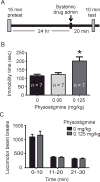Ventral tegmental area cholinergic mechanisms mediate behavioral responses in the forced swim test
- PMID: 25865152
- PMCID: PMC4443858
- DOI: 10.1016/j.bbr.2015.04.002
Ventral tegmental area cholinergic mechanisms mediate behavioral responses in the forced swim test
Abstract
Recent studies revealed a causal link between ventral tegmental area (VTA) phasic dopamine (DA) activity and pro-depressive and antidepressant-like behavioral responses in rodent models of depression. Cholinergic activity in the VTA has been demonstrated to regulate phasic DA activity, but the role of VTA cholinergic mechanisms in depression-related behavior is unclear. The goal of this study was to determine whether pharmacological manipulation of VTA cholinergic activity altered behavioral responding in the forced swim test (FST) in rats. Here, male Sprague-Dawley rats received systemic or VTA-specific administration of the acetylcholinesterase inhibitor, physostigmine (systemic; 0.06 or 0.125mg/kg, intra-cranial; 1 or 2μg/side), the muscarinic acetylcholine receptor (AChR) antagonist scopolamine (2.4 or 24μg/side), or the nicotinic AChR antagonist mecamylamine (3 or 30μg/side), prior to the FST test session. In control experiments, locomotor activity was also examined following systemic and intra-cranial administration of cholinergic drugs. Physostigmine administration, either systemically or directly into the VTA, significantly increased immobility time in FST, whereas physostigmine infusion into a dorsal control site did not alter immobility time. In contrast, VTA infusion of either scopolamine or mecamylamine decreased immobility time, consistent with an antidepressant-like effect. Finally, the VTA physostigmine-induced increase in immobility was blocked by co-administration with scopolamine, but unaltered by co-administration with mecamylamine. These data show that enhancing VTA cholinergic tone and blocking VTA AChRs has opposing effects in FST. Together, the findings provide evidence for a role of VTA cholinergic mechanisms in behavioral responses in FST.
Keywords: Acetylcholine; Forced swim test; Mecamylamine; Physostigmine; Scopolamine; Ventral tegmental area.
Copyright © 2015 Elsevier B.V. All rights reserved.
Figures





Similar articles
-
Examining the role of muscarinic M5 receptors in VTA cholinergic modulation of depressive-like and anxiety-related behaviors in rats.Neuropharmacology. 2020 Jul;171:108089. doi: 10.1016/j.neuropharm.2020.108089. Epub 2020 Apr 5. Neuropharmacology. 2020. PMID: 32268153 Free PMC article.
-
Ventral tegmental area muscarinic receptors modulate depression and anxiety-related behaviors in rats.Neurosci Lett. 2016 Mar 11;616:80-5. doi: 10.1016/j.neulet.2016.01.057. Epub 2016 Jan 29. Neurosci Lett. 2016. PMID: 26828299 Free PMC article.
-
Cholinergic Receptor Blockade in the VTA Attenuates Cue-Induced Cocaine-Seeking and Reverses the Anxiogenic Effects of Forced Abstinence.Neuroscience. 2019 Aug 10;413:252-263. doi: 10.1016/j.neuroscience.2019.06.028. Epub 2019 Jul 2. Neuroscience. 2019. PMID: 31271832 Free PMC article.
-
Cholinergic tone in ventral tegmental area: Functional organization and behavioral implications.Neurochem Int. 2018 Mar;114:127-133. doi: 10.1016/j.neuint.2018.02.003. Epub 2018 Feb 10. Neurochem Int. 2018. PMID: 29438716 Review.
-
A threshold model for opposing actions of acetylcholine on reward behavior: Molecular mechanisms and implications for treatment of substance abuse disorders.Behav Brain Res. 2016 Oct 1;312:148-62. doi: 10.1016/j.bbr.2016.06.022. Epub 2016 Jun 15. Behav Brain Res. 2016. PMID: 27316344 Free PMC article. Review.
Cited by
-
Multiple cholinesterase inhibitors have antidepressant-like properties in the mouse forced swim test.Behav Brain Res. 2021 Jul 9;409:113323. doi: 10.1016/j.bbr.2021.113323. Epub 2021 Apr 25. Behav Brain Res. 2021. PMID: 33910028 Free PMC article.
-
Medial prefrontal cortex acetylcholine signaling mediates the ability to learn an active avoidance response following learned helplessness training.Neuropsychopharmacology. 2024 Dec;50(2):488-496. doi: 10.1038/s41386-024-02003-0. Epub 2024 Oct 3. Neuropsychopharmacology. 2024. PMID: 39362985
-
Cholinergic regulation of mood: from basic and clinical studies to emerging therapeutics.Mol Psychiatry. 2019 May;24(5):694-709. doi: 10.1038/s41380-018-0219-x. Epub 2018 Aug 17. Mol Psychiatry. 2019. PMID: 30120418 Free PMC article. Review.
-
Examining the role of muscarinic M5 receptors in VTA cholinergic modulation of depressive-like and anxiety-related behaviors in rats.Neuropharmacology. 2020 Jul;171:108089. doi: 10.1016/j.neuropharm.2020.108089. Epub 2020 Apr 5. Neuropharmacology. 2020. PMID: 32268153 Free PMC article.
-
Repurposing Cholinesterase Inhibitors as Antidepressants? Dose and Stress-Sensitivity May Be Critical to Opening Possibilities.Front Behav Neurosci. 2021 Jan 14;14:620119. doi: 10.3389/fnbeh.2020.620119. eCollection 2020. Front Behav Neurosci. 2021. PMID: 33519395 Free PMC article. Review.
References
-
- Kessler RC, et al. The epidemiology of major depressive disorder: results from the National Comorbidity Survey Replication (NCS-R) JAMA. 2003;289(23):3095–105. - PubMed
-
- Bella R, et al. Clinical presentation and outcome of geriatric depression in subcortical ischemic vascular disease. Gerontology. 2010;56(3):298–302. - PubMed
Publication types
MeSH terms
Substances
Grants and funding
LinkOut - more resources
Full Text Sources
Other Literature Sources
Miscellaneous

